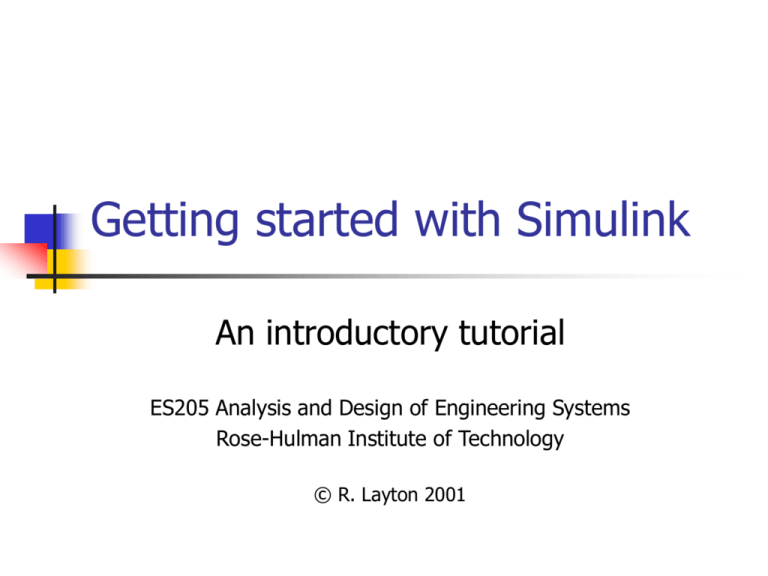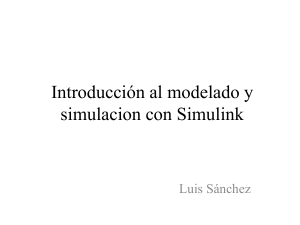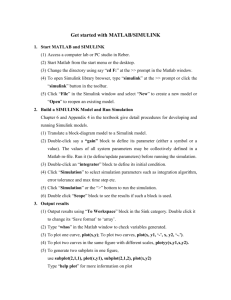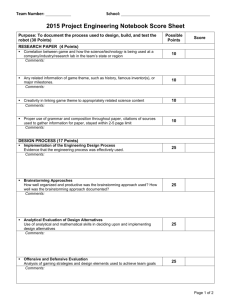Getting started with Simulink - Rose
advertisement

Getting started with Simulink An introductory tutorial ES205 Analysis and Design of Engineering Systems Rose-Hulman Institute of Technology © R. Layton 2001 Before we start You should have network access to software through Application Explorer on your desktop. If not, contact the Technical Services Center (TSC): Help Desk at 877-8989 Dial 6000 and say "Help Desk" Visit the TSC in Crapo Hall, Room G-139 E-mail to helpdesk@rose-hulman.edu Launch Matlab Application explorer (ZENworks) [All] Matlab 5.3 Launch Simulink In the MATLAB command window, at the >> prompt, type simulink and press Enter Create a new model Click the new-model icon in the upper left corner to start a new Simulink file Select the Simulink icon to obtain elements of the model Your workspace Library of elements Model is created in this window Save your model You might create a new folder, like the one shown below, called simulink_files Use the .mdl suffix when saving Example 1: a simple model Build a Simulink model that solves the differential equation x 3 sin 2t Initial condition x(0) 1. First, sketch a simulation diagram of this mathematical model (equation) (3 min.) Simulation diagram Input is the forcing function 3sin(2t) Output is the solution of the differential x(0) 1 equation x(t) 3sin(2t) (input) x 1 s x x(t) (output) integrator Now build this model in Simulink Select an input block Drag a Sine Wave block from the Sources library to the model window Select an operator block Drag an Integrator block from the Continuous library to the model window Select an output block Drag a Scope block from the Sinks library to the model window Connect blocks with signals Place your cursor on the output port (>) of the Sine Wave block Drag from the Sine Wave output to the Integrator input Drag from the Integrator output to the Scope input Arrows indicate the direction of the signal flow. Select simulation parameters Double-click on the Sine Wave block to set amplitude = 3 and freq = 2. This produces the desired input of 3sin(2t) Select simulation parameters Double-click on the Integrator block to set initial condition = -1. This sets our IC x(0) = -1. Select simulation parameters Double-click on the Scope to view the simulation results Run the simulation In the model window, from the Simulation pulldown menu, select Start View the output x(t) in the Scope window. Simulation results To verify that this plot represents the solution to the problem, solve the equation analytically. The analytical result, x(t ) 12 32 cos2t matches the plot (the simulation result) exactly. Example 2 Build a Simulink model that solves the following differential equation 2nd-order mass-spring-damper system zero ICs input f(t) is a step with magnitude 3 parameters: m = 0.25, c = 0.5, k = 1 mx cx kx f (t ) Create the simulation diagram On the following slides: The simulation diagram for solving the ODE is created step by step. After each step, elements are added to the Simulink model. Optional exercise: first, sketch the complete diagram (5 min.) mx cx kx f (t ) (continue) First, solve for the term with highestorder derivative mx f (t ) cx kx Make the left-hand side of this equation the output of a summing block mx summing block Drag a Sum block from the Math library Double-click to change the block parameters to rectangular and + - - (continue) Add a gain (multiplier) block to eliminate the coefficient and produce the highest-derivative alone mx summing block 1 m x Drag a Gain block from the Math library The gain is 4 since 1/m=4. Double-click to change the block parameters. Add a title. (continue) Add integrators to obtain the desired output variable mx summing block 1 m x 1 s x 1 s x Drag Integrator blocks from the Continuous library ICs on the integrators are zero. Add a scope from the Sinks library. Connect output ports to input ports. Label the signals by double-clicking on the leader line. (continue) Connect to the integrated signals with gain blocks to create the terms on the right-hand side of the EOM mx summing block x 1 m cx 1 s x c kx k 1 s x Drag new Gain blocks from the Math library To flip the gain block, select it and choose Flip Block in the Format pull-down menu. Double-click on gain blocks to set parameters Connect from the gain block input backwards up to the branch point. Re-title the gain blocks. c=0.5 k=1.0 Complete the model f(t) input Bring all the signals and inputs to the summing block. Check signs on the summer. + - mx 1 m x cx kx x 1 s 1 s x x c k x x(t) output Double-click on Step block to set parameters. For a step input of magnitude 3, set Final value to 3 Final Simulink model Run the simulation Results Underdamped response. Overshoot of 0.5. Final value of 3. Is this expected? Paper-and-pencil analysis based on the equations of motion Standard form x k m c 1 x x f (t ) k k Nat’l freq. k n 2.0 m Damping ratio 2 Static gain c 0.5 n k K 1 1 k Check simulation results Damping ratio of 0.5 is less than 1. Expect the system to be underdamped. Expect to see overshoot. Static gain is 1. Expect output magnitude to equal input magnitude. Input has magnitude 3, so does output. Simulation results conform to expectations. End of tutorial





